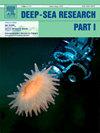中太平洋Clarion-Clipperton-Fracture带蛇科和星科的营养生态学研究
IF 2.1
3区 地球科学
Q2 OCEANOGRAPHY
Deep-Sea Research Part I-Oceanographic Research Papers
Pub Date : 2025-09-23
DOI:10.1016/j.dsr.2025.104598
引用次数: 0
摘要
深海海洋占地球表面的50%以上,但对这些生态系统中动物的生活史特征仍然知之甚少。在Clarion-Clipperton断裂带(CCZ) 3800 ~ 4800 m水深范围内,蛇总科约占无脊椎巨型动物组合的三分之一;小行星以较低的密度存在。我们假设(1)蛇尿总科、异生总科和六足总科存在捕食-被捕食关系,其中蛇尿总科以有孔虫和海绵来源的有机物(OM)为食。(2)蛇蝇科对新鲜植物碎屑的依赖性降低。briingida (Asteroidea目),经常附着在茎上,以便更容易接触到沉入海底的颗粒物OM。为了验证这三个假设,我们将动物群(蛇尾亚科、星形亚科)和沉积物的体积和化合物特异性稳定同位素分析与CCZ东部海底图像分析结合起来。所有调查的棘皮动物都具有较高的营养水平。磷脂衍生脂肪酸(PLFAs)被用作生物标志物,表明绿叶青杉(Silax daleus)消耗由其肠道微生物群处理的沉积碎屑。蛇棘菌(Ophiacantha cosmica)可能是顶级的消费者或清道夫,光棘菌(Ophiosphalma glabrum)是机会性杂食动物,以植物碎屑、细菌、甲壳类和有孔虫为食,而多棘菌(Ophiuroglypha cf. polyacantha, sp. 6)是更具选择性的杂食动物。Freyella benthophila主要栖息在hexactinellia的茎上,并利用这个较高的位置捕捉植物碎屑和浮游动物。相比之下,Freyastera cf. tuberculata主要栖息在多金属结核上,从那里捕食在沉积物表面移动的甲壳类动物。我们证实了蛇蝇科对植物碎屑的依赖程度较低,它们消耗有孔虫和海绵来源的OM。本文章由计算机程序翻译,如有差异,请以英文原文为准。
Trophic ecology of Ophiuroidea and Asteroidea in the Clarion-Clipperton-Fracture Zone (Central Pacific)
Abyssal seascapes represent over 50 % of the Planet's surface, but the life history traits of fauna present in these ecosystems remain poorly understood. Ophiuroidea constitute about one third of the invertebrate megabenthos assemblage between 3800 m and 4800 m water depth in the Clarion-Clipperton Fracture Zone (CCZ); Asteroidea are present in lower densities. We hypothesize that (1) Ophiuroidea, Xenophyophoroidea, and Hexactinellida have a predator-prey relationship, where Ophiuroidea feed on foraminifera- and sponge-derived organic matter (OM). (2) Ophiuroidea have a reduced dependency on fresh phytodetritus. (3) Brisingida (order of Asteroidea), often cling to stalks to have easier access to particulate OM sinking to the seafloor.
To test these three hypotheses, we combined bulk and compound-specific stable isotope analyses of fauna (Ophiuroidea, Asteroidea) and sediments with analyses of seafloor images from the eastern CCZ.
All investigated Echinodermata species had a high trophic level. Phospholipid-derived fatty acids (PLFAs) used as biomarkers suggest that Silax daleus consumes sedimentary detritus that is processed by its gut microbiome. Ophiacantha cosmica is likely a top consumer or scavenger, Ophiosphalma glabrum is an opportunistic omnivore ingesting phytodetritus, bacteria, Crustacea, and Foraminifera, while Ophiuroglypha cf. polyacantha (sp. 6) is a more selective omnivore. Freyella benthophila sits mostly on stalks of Hexactinellida and uses this elevated position to catch phytodetritus and zooplankton. Freyastera cf. tuberculata, in comparison, sits mostly on polymetallic nodules from where it preys upon Crustacea moving on the sediment surface. We confirmed that Ophiuroidea are less dependent on phytodetritus, and they consume foraminifera- and sponge derived OM.
求助全文
通过发布文献求助,成功后即可免费获取论文全文。
去求助
来源期刊
CiteScore
4.60
自引率
4.20%
发文量
144
审稿时长
18.3 weeks
期刊介绍:
Deep-Sea Research Part I: Oceanographic Research Papers is devoted to the publication of the results of original scientific research, including theoretical work of evident oceanographic applicability; and the solution of instrumental or methodological problems with evidence of successful use. The journal is distinguished by its interdisciplinary nature and its breadth, covering the geological, physical, chemical and biological aspects of the ocean and its boundaries with the sea floor and the atmosphere. In addition to regular "Research Papers" and "Instruments and Methods" papers, briefer communications may be published as "Notes". Supplemental matter, such as extensive data tables or graphs and multimedia content, may be published as electronic appendices.

 求助内容:
求助内容: 应助结果提醒方式:
应助结果提醒方式:


